There are many things we need to prepare for before the ball drops, (SHTF, TEOTWAWKI, or whatever term you want to use) like water, food, shelter, bullets, medical supplies, aetc. But another item I feel is very important is communication with my family group. This article is about how I got into amateur radio, how I setup my basic solar-powered ham radio shack, and how I stay in practice with my equipment in my shack.
I had been interested in Amateur Radio (a.k.a. “ham” radio) since I was a little boy, more than 50 years ago. I will soon be 68 years old. I often looked into getting my radio operator license but back in those days Morse code was required. I attempted many times to learn Morse code, but I finally decided that my hand-to-brain transfer was way too slow to learn such a fast moving process. I had someone tell me that I shouldn’t have any problem learning code since I was a musical person. (I have been playing the guitar over 50 years now.) He said code was all about the rhythm of the dots and dashes. But not for me, I just could not get it! Finally, everything changed… no code!! This requirement was removed on December 15, 2006. So six years later my twin brother and I decided to go for it! I don’t know why we waited so long.
So finally my adventure into ham radio began. I got my amateur license in April 2012 alongside my brother who got his license the same day. We sat beside each other taking the exam and received consecutive call sign numbers. We both studied for our General Class and passed first try. There are study sites on the internet that will get you ready for the test. This is what my brother and I used. The Amateur Radio Operator license is good for 10 years at which time you must go online and renew it. Renewal is required every 10 years. There is no additional test to take for renewal. Just go to the FCC web page and go through the renewal process.
Now to the basic setup I have for communication. I decided to go with the HF (high frequency) setup first since my brother lived about 120 miles away. We wanted something that would talk that distance without going through a repeater like the 2-meter radios would have to do for that distance. Also, we wanted to do the digital mode (Fldigi PSK31) so we went for the HF and the General Class.
I chose a basic model HF rig and it has served me well. I haven’t seen a need to upgrade to anything else. I have an Icom IC-718 HF radio which many would consider an entry-level HF rig, but it does all that I need it to do. (One of these is pictured at the top of this article.) It puts out 100 watts, but on the digital modes, in most cases, only low power of 10-20 watts is needed. To be able to work with the digital mode of course you will need a computer to operate some software, some device to connect the computer to the radio, some coaxial cable (“coax”), and an antenna.
The device that I use to connect my computer to my radio is a SignaLink USB with the required cable. The SignaLink can be bought already setup for the HF radio you plan to use it with. Fldigi is a free digital software program you can download from the internet. There are many videos online showing how to set things up, and if you are reasonably computer savvy you should not have any problem getting it going.
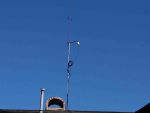 My antenna is a Windom OCF (off-center feed) inverted V-shaped dipole wire antenna. I mounted it on top of my house about 30 feet above the ground. This antenna, with a tuner, is capable of operating from 80 Meter (3.5 MHz) up to 10 Meter (28 MHz), which is the same frequency that my ICOM IC-718 HF radio operates on. For some reason, I’ve never been able to get my antenna and tuner to operate on 160 Meter (1.8 MHz). This type of antenna is available for purchase online, however, a lot of the fun of the ham hobby is making some of the items yourself.
My antenna is a Windom OCF (off-center feed) inverted V-shaped dipole wire antenna. I mounted it on top of my house about 30 feet above the ground. This antenna, with a tuner, is capable of operating from 80 Meter (3.5 MHz) up to 10 Meter (28 MHz), which is the same frequency that my ICOM IC-718 HF radio operates on. For some reason, I’ve never been able to get my antenna and tuner to operate on 160 Meter (1.8 MHz). This type of antenna is available for purchase online, however, a lot of the fun of the ham hobby is making some of the items yourself.
Of course, when the SHTF, or if a storm takes down your antenna, if you have the materials on hand, you can made another one and be back in operation. I went online and found some instructions on how to make a wire antenna, bought the items, and put together my antenna myself. It is also a good idea to print these instructions before there might be no grid power, no Internet, and no printer. I also have a book in my collection from the American Radio Relay League (ARRL) called the ARRL’s Wire Antenna Classics. This is a good reference book to have, however, this book may go into much more detail than some people may want.
The antenna that I made uses a balun, which is a balanced to un-balanced device that makes the antenna and the coax work together correctly. Things get deep quick when we start talking about matching the ohms with the resonator and why a balun is needed, so I’m just keeping things simple here. I also bought the items and made my own balun. To make all of the different bands (groups of frequencies) operate on the same antenna I opted to add an automatic tuner. I chose the LDG Electronics AT-1000 AUTOTUNER. This has the capacity for 1,000 watts just in case I want to add an amplifier. Later, I did add an Ameritron ALS-600 (600-watt output) solid-state amplifier, I rarely use the amplifier, but it is better to have and not use very often than need it later and not have it!! The only other item needed is coax to connect the radio to the tuner and the tuner to the antenna.
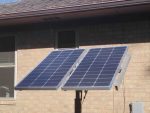 To power all of these items a 110-120 volt AC to 13.8 volt DC power supply is also needed. In my case, I decided to set things up so it would work off grid or without 110 volts AC. So I have all of the radio station, including my laptop computer that runs the Fldigi software, set up to operate on photovoltaic solar power. I have two 100 watt solar panels with a 100 amp-hour 12 volt LiFePO4 battery. The solar panels keep the battery charged for times when the sun is not out for a few days and of course for night time operation. As a note, the ALS-600 watt amplifier doesn’t operate off of the solar panels. It has a power supply that operates on 110 volts AC.
To power all of these items a 110-120 volt AC to 13.8 volt DC power supply is also needed. In my case, I decided to set things up so it would work off grid or without 110 volts AC. So I have all of the radio station, including my laptop computer that runs the Fldigi software, set up to operate on photovoltaic solar power. I have two 100 watt solar panels with a 100 amp-hour 12 volt LiFePO4 battery. The solar panels keep the battery charged for times when the sun is not out for a few days and of course for night time operation. As a note, the ALS-600 watt amplifier doesn’t operate off of the solar panels. It has a power supply that operates on 110 volts AC.
 That is the rundown for my HF setup. For 2 Meter handhelds, I have three Baofeng UV5R radios. I use the “two is one and one is none” mindset. I also have an ICOM IC-T70A. In the area where I live there are many 2 Meter repeaters and one of those repeaters operates off of solar panels. That is a big plus in a grid down situation, however, if an EMP hits I’m sure that would render all of the repeaters non-usable along with any solid state radios including the 2 Meter handy talkie (HT) radios that are not stored in a Faraday box.
That is the rundown for my HF setup. For 2 Meter handhelds, I have three Baofeng UV5R radios. I use the “two is one and one is none” mindset. I also have an ICOM IC-T70A. In the area where I live there are many 2 Meter repeaters and one of those repeaters operates off of solar panels. That is a big plus in a grid down situation, however, if an EMP hits I’m sure that would render all of the repeaters non-usable along with any solid state radios including the 2 Meter handy talkie (HT) radios that are not stored in a Faraday box.
When I bought my Baofeng radios they were early-generation open-frequency radio models, meaning that you could program in a frequency to both receive and transmit for the FRS frequancies. On FRS frequencies only 1/2 to 2 watts is allowed depending on the frequency, although 4 watts is possible with the Baofeng UV5R. These radios can no longer be purchased new as of September 30, 2019. There is a simple free programming guide called “CHIRP” that can be used to program these radios and other radios similar to them. This is what I use to program my radios. With this program, you can copy the frequencies from one radio and paste them right into another radio, simple “copy and paste”. The CHIRP program will require a patch cord to connect the radio to the computer. These are available online. The CHIRP software is recommended as these radios can be quite tricky to program manually.
For my 2 Meter base station I have a Kenwood TM-281 radio. This is a single band 2 Meter radio designed for mobile use, however, it can be used as a base station using a 13.8 volt DC power supply, or in my case a solar panel with a 12 volt lithium battery. For an antenna I have a home built dual band J pole (see attached picture). These plans are available on the internet just by doing a Google search for DIY dual band J pole antenna. Mine is made from 1/2” copper tubing. This is a very good afternoon project for one of those cold winter days. I chose the dual band (2 Meter 144 MHz and 70 cm 420 MHz) because my handy talkie (HT) can operate on the 420 MHz frequency and I have an adapter to connect those radios to the dual band base antenna. The only other item needed is a coax to connect the radio to the dual band 2 Meter / 70 centimeter antenna.
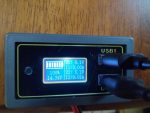 The foregoing description of the solar panel and battery setup is also used to keep my HT radios charged. The ICOM handy talkie is 12 volt DC and it stays charged straight from the 12 volt battery, however, the Baofeng radios are only 9 volts. For these, I use a DC/DC converter to reduce the voltage from 12 Volts down to the required 9 volts. This is a setup that I saw on SurvivalBlog by Contributor Tunnel Rabbit back in February of 2023.
The foregoing description of the solar panel and battery setup is also used to keep my HT radios charged. The ICOM handy talkie is 12 volt DC and it stays charged straight from the 12 volt battery, however, the Baofeng radios are only 9 volts. For these, I use a DC/DC converter to reduce the voltage from 12 Volts down to the required 9 volts. This is a setup that I saw on SurvivalBlog by Contributor Tunnel Rabbit back in February of 2023.
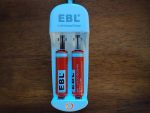
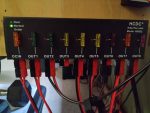 The solar panel/battery power I have set up is also being used to charge cell phones, power packs, and rechargeable batteries for my flashlights. For charging my 14500 3.7 volt rechargeable batteries I use an EBL Li-ion Universal Charger. Input power on it is 5 volt DC and uses a standard micro USB charging plug. I even keep my rechargeable hearing aids charged using this setup. My experience has been that anything I have that is charged by a USB cord has charged with my solar/battery setup using a USB charge plug. I have all of my radios and charging devices connected with Anderson Power Pole connectors.
The solar panel/battery power I have set up is also being used to charge cell phones, power packs, and rechargeable batteries for my flashlights. For charging my 14500 3.7 volt rechargeable batteries I use an EBL Li-ion Universal Charger. Input power on it is 5 volt DC and uses a standard micro USB charging plug. I even keep my rechargeable hearing aids charged using this setup. My experience has been that anything I have that is charged by a USB cord has charged with my solar/battery setup using a USB charge plug. I have all of my radios and charging devices connected with Anderson Power Pole connectors.
To stay in practice using the ham radios, there are many nets around that have weekly check-ins both HF and on 2 meter bands. Or you can set up a weekly time to get on the radio with family and friends. This is the system my brother and I use to stay in touch and to stay in practice with our radios. When we got into ham radios we lived 120 miles apart, so every Saturday night at 7:00 PM local time we would have “radio time”. We would get on 80 meter on PSK-31 and make contact and chit-chat a bit.
Sure, I could call him on his cell phone as long as things are like they are now, but possibly very soon, that could all change. No one knows. As they say: “hope for the best but plan for the worst”. Since my brother retired about 3 years ago, he has moved a lot closer to where I live. He is now about 30 miles away but there is quite a tall hill between us. We can’t talk 2 meter simplex, which means not going through a 2 meter repeater, so we are still using 80 meters to make our weekly radio contact.
I do want to note that I do not have any affiliation to any of the products that I have mentioned in this article. They are just products that I have used and they have performed well for me.
Well, this is my adventure of getting into ham radio. I hope that it may inspire someone who has always thought about getting into a hobby just for fun, or wanting a backup method of staying in touch with family and friends. Who knows, maybe someone will be inspired to set up a neighborhood watch group with other ham operators. Now is the time to get busy and make it happen.










